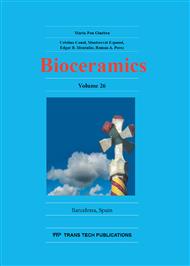p.402
p.408
p.414
p.420
p.426
p.430
p.435
p.443
p.448
Bone Induction in Porous HAp Block Modified by Partial Dissolution-Precipitation Technique with Supersonic Treatment in Rat Scalp
Abstract:
Microcracks and trabecular fractures can be observed in physiological bone. Biomimetic hydroxyapatite (HAp) scaffolds have been strongly needed in bone regenerative medicine. We have been developing the combination method of the partial dissolution-precipitation techniques involving the stirring-supersonic treatment in 1.7×10-2 N HNO3 solution containing Ca2+and PO43- ions to improve the surface and the bulk of commercially available synthetic HAp block (82.5% in porosity, 50-300µm in macropore). The modified HAp was named as a partially dissolved and precipitated HAp (PDP-HAp). The aims of this study are to characterize the PDP-HAp and to observe cell response for the ceramics in rat scalp tissue. The PDP-HAp exhibited the macropore sizes of 50-200µm, the porosities of 85-90%, and the specific surface areas of 1.0-2.0 m2・g-1, with many micro-cracks. Twenty rats were divided into 2 groups. At 9 months, bone induction occurred inside the many pores in the PDP-HAp group, while bone and cartilage were not found in the HAp group. We believe that osteoinduction by the PDP-HAp is different from the process of BMP-loaded HAp-induced bone formation. The PDP-HAp might be applied as potential ceramics with osteoinductive properity and excellent biocompatibility in difficult bone regenerative cases.
Info:
Periodical:
Pages:
430-434
Citation:
Online since:
November 2014
Authors:
Keywords:
Price:
Сopyright:
© 2015 Trans Tech Publications Ltd. All Rights Reserved
Share:
Citation:


